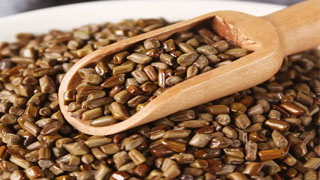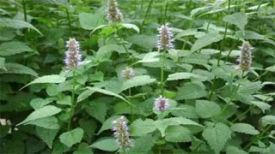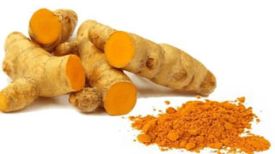
1. Alias
Fake mung beans, fine leaf pig poop beans, horseshoe cassia seeds, iris seeds, and night pull seeds.
2. Plant morphology
Annual semi shrub like herb. There are many branches in the upper part. Leaves alternate, with feather like compound leaves; There are three pairs of small leaves, with the leaves being oblong or inverted ovate in shape, with a rounded tip and a wedge-shaped base that is slightly skewed. The underside and edges are covered in soft hairs, and there is a strip of glandular tissue between the lowest pair of small leaves, or one glandular tissue between each of the two pairs of small leaves below. Flowers grow in pairs axillary, clustered at the top; The total flower stem is extremely short; Sepals 5, inverted; The corolla is yellow, with 5 petals, inverted in shape, and claws at the base; 10 stamens, 7 developing stamens, and 3 larger anthers with narrow and bottleneck shaped tips; The ovary is slender and the style is curved. The pods are slender and nearly quadrilateral in shape; The seeds are mostly prismatic or diamond shaped, slightly flattened, light brown, shiny, and have one linear oblique concave pattern on each side. The flowering period is from June to August, and the fruiting period is from August to October.
3. Origin distribution
Born on the outskirts of villages, roadsides, slopes, and other places. Distributed in Jiangsu, Anhui and other places.
4. Harvesting and processing
When the fruits mature and the pods turn yellow brown at the end of autumn, harvest them. Cut off the whole plant, dry it in the sun, seed it, and remove impurities.
5. Characteristics of medicinal herbs
Four sided short cylindrical shape, with one end blunt and rounded, and the other end inclined and pointed, measuring 4-6 millimeters in length and 2-3 millimeters in width. The surface is brownish green or dark brown, smooth and glossy, with a raised edge on both the back and abdomen. There is a light brown linear depression on both sides of the edge line that slopes from the navel to the junction. Hard in texture. Thin seed coat on the transverse surface; The endosperm is gray white and semi transparent. Embryo yellow, with two overlapping cotyledons and an S-shaped bend. The intact seeds have no bean odor, but there is a weak bean odor after crushing; Slightly bitter in taste, slightly sticky.
6. Sexual Taste Returning to the Classics
Slightly cold in nature, bitter and sweet in taste. Return to the liver meridian, kidney meridian, and colon meridian.
7. Effect and Function
Clear heat and improve vision, moisten the intestines and promote bowel movements. It belongs to the category of clearing heat drugs for clearing deficiency and heat.
8. Clinical application
Dosage: 10-15 grams, decoct the soup and take it orally. A large amount can be used up to 30 grams; Or at the end of research; Or make tea to drink. External use: appropriate amount, apply after grinding. Used to treat conditions such as redness, swelling, pain, shyness, excessive tears, and night blindness caused by attacking with deficiency fire or wind heat in the liver meridian; Hot constipation and intestinal dryness constipation; Dizziness and headache caused by liver yang hyperactivity.
9. Pharmacological research
It has antibacterial, anti atherosclerosis, and anti platelet agglutination effects; Inhibit cellular immune function, have no effect on humoral immune function, and enhance macrophage phagocytic function; Liver protection; Diarrhea; Promote gastric juice secretion; Inhibition of 15 hydroxyprostaglandin dehydrogenase. Toxicity: Carcinogenic and reproductive toxicity. Its water infusion has the effects of lowering blood pressure, diuresis, and has the effects of slowing down diarrhea and contracting the uterus; Its alcohol extract has inhibitory effects on Staphylococcus aureus, diphtheria, Bacillus subtilis, typhoid fever, paratyphoid fever, type B paratyphoid fever, Escherichia coli, and other bacteria; Its water extract has inhibitory effects on various pathogenic skin fungi and has a lipid-lowering effect.
10. Chemical composition
Containing free hydroxyl anthraquinone derivatives, it is composed of various components such as quercetin, chrysophanol, emodin, emodin methyl ether, emodin anthraquinone, emodin 6-glucoside, cassitin, cassitin, luteolin, blunt leaf extract, blunt new extract, cassitin anthraquinone, cassitin glycoside, etc. The content of emodin or cassia glycoside A can be determined by HPLC method.
11. Usage taboos
People with spleen deficiency and loose stools should take it with caution.
12. Compatibility prescription
① Treatment for acute conjunctivitis: 15 grams each of Cassia seed, Chrysanthemum, Cicada molt, and Celosia seed. Boil it in water. (Qingdao Herbal Medicine Handbook)
② Treatment of acute keratitis: 15g of cassia seed, 9g of chrysanthemum, 9g of foxtail millet, 9g of catnip, 6g of coptis chinensis, and 12g of mugwort. Boil it in water. (Sichuan Journal of Traditional Chinese Medicine, 1979)
③ Treatment for night blindness: 9 grams each of cassia seed and wolfberry, and an appropriate amount of pig liver. Boil in water, eat liver and take soup. (Zhejiang Medicinal Plant Chronicles)
④ For treating sparrows: 60 grams of Cassia seed and 30 grams of Kochia scoparia. Grind the medicine into fine powder. After each meal, drink 3g of clear Congee. (Holy Blessing Formula)
⊙ The content of the article is for clinical reference only. Non TCM professionals are not allowed to test drugs.


